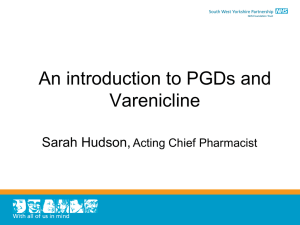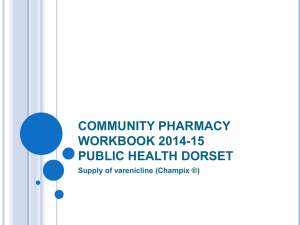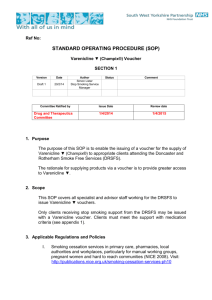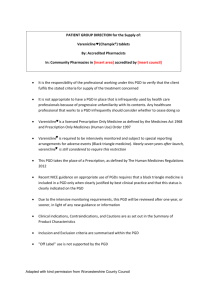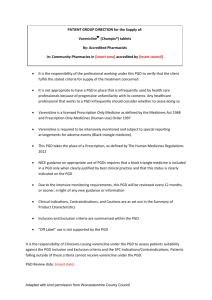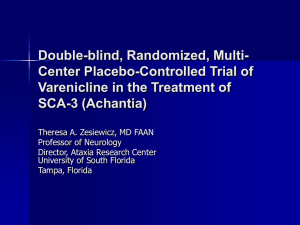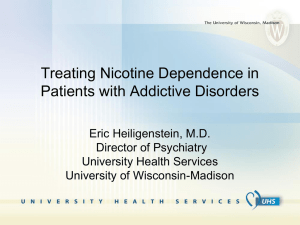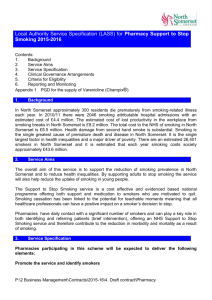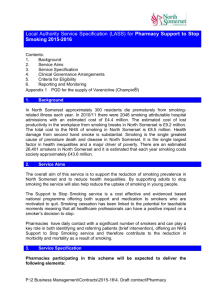SWYFT Champix PGD FINAL 2 – jun14 amendment
advertisement
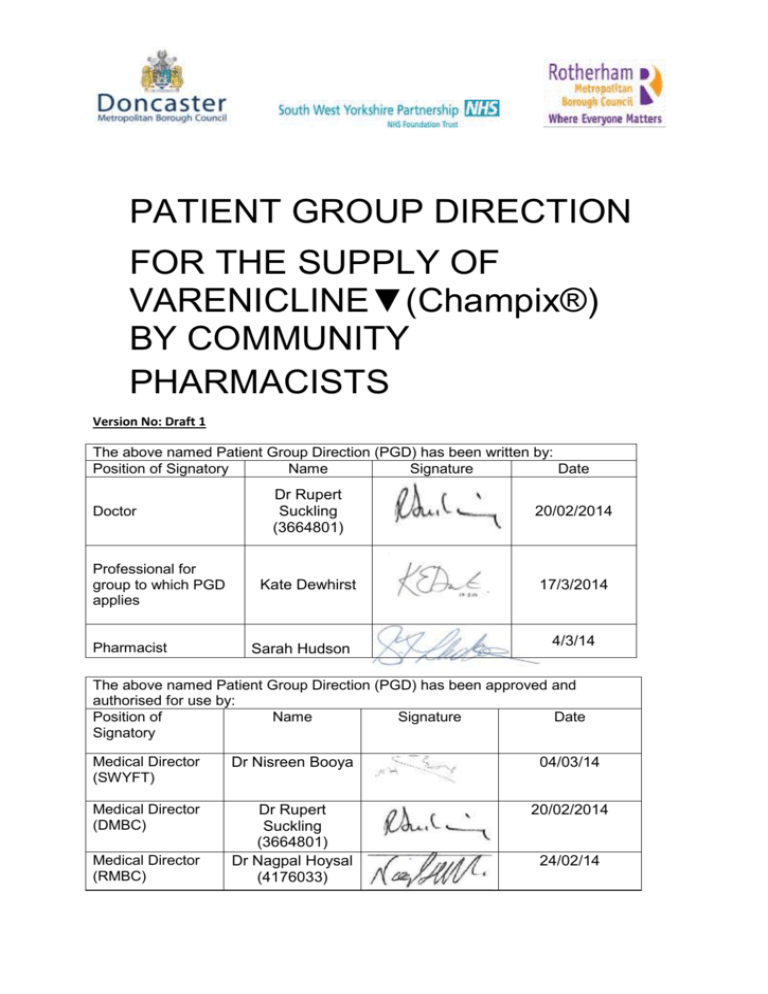
PATIENT GROUP DIRECTION FOR THE SUPPLY OF VARENICLINE▼(Champix®) BY COMMUNITY PHARMACISTS Version No: Draft 1 The above named Patient Group Direction (PGD) has been written by: Position of Signatory Name Signature Date Doctor Professional for group to which PGD applies Pharmacist Dr Rupert Suckling (3664801) 20/02/2014 Kate Dewhirst 17/3/2014 Sarah Hudson 4/3/14 The above named Patient Group Direction (PGD) has been approved and authorised for use by: Position of Name Signature Date Signatory Medical Director (SWYFT) Dr Nisreen Booya 04/03/14 Medical Director (DMBC) Dr Rupert Suckling (3664801) Dr Nagpal Hoysal (4176033) 20/02/2014 Medical Director (RMBC) 24/02/14 Characteristic of staff to which the Patient Group Direction applies. Qualifications required Pharmacist (registered with GPhC) Additional information British National Formulary (latest issue) London: BMA &RPSGB Manufacturers’ Summary of Product Characteristics (SPC) for Varenicline▼(Champix®) : www.medicines.org.uk http://www.medicines.org.uk/EMC/medicine/1 9045/SPC/CHAMPIX++0.5+mg+filmcoated+tablets%3b+CHAMPIX++1+mg+filmcoated+tablets/ (Accessed online 01/05/12) NICE TA123 ‘Varenicline for smoking cessation’ http://www.nice.org.uk/TA123 July 2007(Accessed online 01/05/12) Committee on Safety of Medicines advice Varenicline: adverse psychiatric reactions, including depression http://www.mhra.gov.uk/Safetyinformation/Dru gSafetyUpdate/CON087901 (Accessed online 13/02/14) NICE: Public health guidance, PH10 - Issued: February 2008 Smoking cessation services in primary care, pharmacies, local authorities and workplaces, particularly for manual working groups, pregnant women and hard to reach communities. http://guidance.nice.org.uk/PH10 (Accessed online 13/02/14) Continued training requirements It is the responsibility of the individual pharmacist to ensure that they and their staff are competent in all aspects of supply of Varenicline and are updated on current medicines policies. Date of Implementation of the PGD –1/4/14 Date of the review of this PGD – 1/4/16 Description of Treatment Name of Medication: Form: Dosage: Route to administration: Total dose, duration of treatment, total treatment quantity Varenicline▼ (Champix®) Tablets 0.5mg and 1mg Oral. Swallow tablets whole, take with or without food. Days 1-3: 0.5mg (white tablets) once a day Days 4-7: 0.5mg twice a day Day 8 to end of treatment: 1mg (blue) twice a day For clients who cannot tolerate Varenicline because of adverse effects e.g. nausea, the dose can be temporarily or permanently lowered to 0.5mg twice a day as per SPC. The rationale for dose reduction should be documented in the Patient Medication Record (PMR). Duration: Up to 12 weeks: Supply 1 – Two weeks titration pack Supply 2 - Two weeks (1mg x 28 tablets) Supply 3 - Two weeks (1mg x 28 tablets) Supply 4 - Two weeks (1mg x 28 tablets) Supply 5 - Two weeks (1mg x 28 tablets) Supply 6 - Two weeks (1mg x 28 tablets) Clients should set a quit date and start treatment with Varenicline 1 to 2 weeks before this date. Clients must attend the same pharmacy for all supplies of Varenicline. A break in treatment of up to 3 days is permitted, after this Varenicline must not be supplied and the client should be referred back to the local Smoke Free service. Storage of medication: Store below 30 . Does not require any special storage conditions. Criteria for administration: Client registered with a Doncaster or Rotherham GP Client presents a valid Varenicline voucher to an accredited Varenicline PGD pharmacist. Person is aged 18 years or above. Dependent tobacco users identified as being sufficiently motivated to stop smoking. Person agrees to behavioural support during course of Varenicline Consent has been obtained and recorded. Clients must be informed that information relating to the supply of Varenicline under this PDG needs to be passed to other health service organisations, in particular their GP and their local Smoke Free Service in order to ensure proper record keeping and patient safety. Groups excluded from treatment: Person is aged under 18 years Pregnant or breastfeeding women Persons with renal disease Pregnant or breastfeeding women Persons with known sensitivity to Varenicline or any of its excipients Persons with a history of psychiatric illness Action if excluded Consider using Nicotine Replacement Therapy as an alternative treatment option Document action taken in the Patient Medication Record (PMR). Mild symptoms/reactions: Nausea, vomiting, GI discomfort, diarrhoea, dyspepsia, constipation, increased appetite, somnolence, flatulence, dizziness, headache, drowsiness, dry mouth and fatigue. Severe adverse reaction: Chest pain, psychosis, suicide ideation Procedure for reporting adverse drug reactions: Compliance and adverse reactions will be monitored at the bi-weekly follow-up. Staff will report all adverse reactions in accordance with the UK Adverse Drug Reaction Reporting Guidelines (Yellow card system available at; http://www.yellowcard.gov.uk/). The MHRA recommend all adverse reactions to black triangle medications should be reported. Clients who report agitation/ depression/ suicide ideation /change of mood must stop treatment immediately and seek prompt medical advice. Clients who report new or worsening cardiovascular symptoms must stop treatment immediately and seek prompt medical advice. Written and verbal advice for patient/carer: The product should be labelled in accordance with legal requirements Supply copy of manufacturers patient information leaflet Swallow tablets whole, with a full glass of water immediately after food Patients should be advised to set a quit date 10 to 14 days after initiation Product advice on dosage, method of administration and side effects Patient should contact their GP or pharmacist if they experience any serious side effects The main reasons for Varenicline failure are unrealistic expectations lack of preparation for the fact Varenicline may cause nausea insufficient or incorrect use The patient should understand the following points Varenicline is not a magic cure; effort and determination are crucial works by acting on parts of the brain which are affected by nicotine in cigarettes it does not remove all temptation to stop, but it does make abstinence easier Varenicline is safe, however a third of people will experience mild nausea 30 minutes after taking it. This effect usually diminishes gradually over the first few weeks and most patients tolerate it without problems. stopping smoking may cause weight gain be aware of drowsiness if driving or operating machinery patients on insulin should monitor their blood more closely At the end of treatment discontinuation of Varenicline has been associated with an increase in irritability, urge to smoke, depression and/or insomnia. Record of supply/administration: Pharmacists are required to keep a record of the consultation and supply in the Patient Medication Records (PMR). The supply of Varenicline should also be recorded on Quitmanager. Since Varenicline is a’ black triangle’ drug, all adverse reactions should be reported to the CSM, using the yellow card reporting system. Follow-up: Clients will be seen by the Stop Smoking Advisor weekly for at least 4 weeks after the quit date and by the pharmacist at each supply of Varenicline. Criteria for the stopping Varenicline treatment immediately: The Client does not want to continue treatment. The stop smoking advisor or pharmacist believes that Varenicline treatment is no longer appropriate. An absolute contra-indication is brought to light or develops. A Client develops agitation, depressed mood, suicidal thoughts or other serious mood changes (client to be referred to GP for prompt medical advice) Side effect is so severe as to impair quit attempt Management of Patient Group Direction The Patient Group Direction is to be read, agreed to and signed by all health care professionals it applies to: The original signed copy being kept by the nominated person with responsibility for PGDS within the service area. I confirm that I have read and understood the content of this Patient Group Direction and that I am willing and competent to work under it within my professional code of conduct. Name of authorised health care professional Signature of health care professional Date
